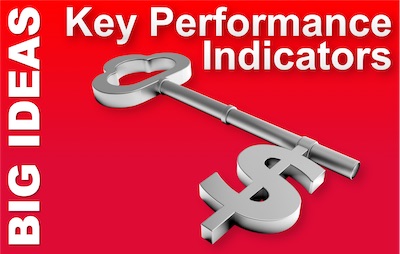
 Key Performance Indicators – or KPIs – stem from an insight that is most often attributed to Peter Drucker, in his 1954 book titled, ‘The Practice of Management’:
Key Performance Indicators – or KPIs – stem from an insight that is most often attributed to Peter Drucker, in his 1954 book titled, ‘The Practice of Management’:
‘What gets measured gets managed’
That attribution may be contested, but the central assertion seems pretty sound. If your organisation measures performance against a specific metric, then its managers feel an incentive to manage their parts of the business, so that they perform well against that metric. KPIs are nothing more nor less than the key – or most valuable – metrics.
What are KPIs?
KPIs are Key Performance Indicators:
- Key – the things that matter most
- Performance – how you’re doing
- Indicator – a signal that gives a representation of the truth
So, a KPI is a quantifiable measure that gives a guide to how well (or poorly) an organisation is performing. They measure performance against individual targets, objectives, or milestones.
KPIs at different levels
We can define KPIs at any level within an organisation:
- Organisation-wide
- Departmental
- Functional
- Team-level
- Individual
One of the things that makes them work well – and this is reminiscent of Management by Objectives – is when they cascade in a self-consistent way:
- Individual KPIs contribute to team KPIs
- Team KPIs contribute to departmental or functional KPIs
- And these contribute to enterprise-level KPIs
What sort of Measures?
KPI’s can be financial or not, but must be expressable in numerical terms – either as a:
- Cardinal number, such as ‘gross revenue = £1.237 million’
- Proportion, such as ’38 percent of customers report high or very high satisfaction’
- Relative, ordinal number, such as ‘3rd place by sales volume in Quarter 2’
- Derived measure, such as ‘$129,000 gross revenue per employee’
- Statistical measure, such as ‘Mean number of daily deliveries: 14.6’
- Qualitative, subjective assessment, such as ‘Risk rating: Amber/Red’
- Time, such as ‘Average meal preparation time: 2 minute 28 seconds’
Enterprise Level KI Ratios
Over the years, accountants and analysts have dedicated a huge amount of y=work to finding derived measures that make effective KPIs. Many of these are ratios, such as:
- Return on equity
- Return on net assets
- Operating profit margin
- Fixed asset turnover
- Inventory turnover
- Debt ratio
- Interest coverage ratio
- Cash flow ratio
Why Do We Use KPIs?
KPIs are used for three principal purposes, and often for more than one at a time. The balance of their priority will usually depend on where in the organisational hierarchy the KPI is measured. Thee three purposes are:
- Assessment
How are we doing? We use KPI’s to gauge performance level against pre-determined criteria or objectives. - Decision-making
What should we do or change? We use KPIs to help inform our operational and strategic business decisions. - Action
We use KPIs to prompt managerial interventions that will (we hope) improve the performance indicator
How to Create Good KPIs
The art is to find close enough measures (ideally) or proxies (if necessary) to the aspects of performance that are truly important. Also, note that all KPI’s are ‘lagging’ indicators. They tell you what has happened. If you can, understand the flow of cause and effect to find KPIs that can also help you forecast trends.
Aggregate Data
You need to be wary of KPIs that represent aggregated data for many things or periods. These can be sums or averages of one sort or another. The danger of these is that, in simplifying the picture, they wash away detail. Sometimes, the detail contains important information that would guide you to a better, more subtle response.
Time Frame
A third consideration is the time frame over which you gather data. For example, a local vehicle dealership would be crazy to look at revenue every day: there’s too much variability. But a supermarket could. However, if there are weekly, monthly, or annual cycles (as there are with car sales), you’ll need to factor that in, too.
Chain of Authority
Finally, a good KPI must be part of a chain of authority. Let’s say a KPI measures an output or outcome for which you will be held accountable. For that to be effective, you must have control over the factors that can influence the performance level; the inputs.
Always start with a small number of simple KPIs. Gradually build up the number and sophistication of the KPIs you use, as you learn about how you are using the data, and what additional information you need, to make your assessments, take decisions, and plan actions.
Oh No… SMART again
Many proponents advocate using the SMART framework to formulate effective KPIs. As you’d expect, there are a number of variants around. Of these, this is the one I like best:
- Specific – a very precise measure
- Measurable – of course
- Assignable – responsibility for the outcome set to one person
- Realistic – don’t set KPI targets you cannot achieve
- Time-frame – for hitting the KPI target
Balanced Scorecard
Most organisations recognise, wisely, that they need a mixed bag of KPIs that measure different aspects of their business. This is the principle behind the Balanced Business Scorecard. This is a business strategy tool developed by Robert Kaplan and David Norton, in 1992.
Balance is also the principle behind John Elkington’s Triple Bottom Line, of Profit, People, and Planet. This is a significant contribution to Corporate Social Responsibility (CSR) and adds ‘responsible’ KPIs to the set of measure we judge organisations on.
What is Your experience of KPIs?
We’d love to hear your experiences, ideas, and questions. Please leave them in the comments below.
